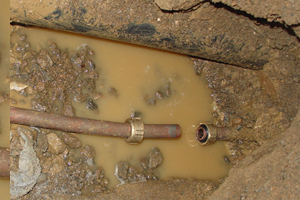
Slab leaks are leaks in plumbing that runs underneath a concrete floor slab. What causes them?
These days most residential and small commercial buildings use this sort of slab-on-grade foundation. It’s more stable, less expensive, and faster to build. But when pipes are run underneath (a common practice) leaks are hard to detect, and often expensive and disruptive to repair. Until they’re found and fixed the resulting dampness can cause mold and other water damage. Larger leaks can even lead to erosion that undermines the foundation and result in structural damage to floors… even walls and ceilings.
We are underground slab leak detection specialists.
[fusion_separator style_type=”default” hide_on_mobile=”small-visibility,medium-visibility,large-visibility” class=”” id=”” sep_color=”” top_margin=”” bottom_margin=”” border_size=”” icon=”” icon_size=”” icon_circle=”” icon_circle_color=”” width=”” alignment=”center”][/fusion_separator]
Causes
So what causes those leaks? In addition to the issues faced by above-ground pipes, essentially underground pipes face additional challenges.
The Usual
All plumbing, regardless of where it’s located, can potentially suffer from leaks for a variety reasons.
- Corrosion from oxygen, alkali, or acidic traces in the water chemistry. This is especially true for the galvanized iron pipes used up through the 1950s.
- Faulty installation (such as poorly soldered or otherwise weak joints) or accidental damage during building construction.
- Poor quality materials.
- Excessive water pressure, particularly water hammer (the physical shock and vibration from flow suddenly stopping).
The 5 Special Causes
Being underground as well as near or within concrete presents special conditions that can lead to slab leaks.
- Settlement. As the soil shifts and settles it can displace pipes, putting them under mechanical strain. That goes double (or more!) for earthquakes.
- Expansive soil shift. Many types of soil expand with water, bending pipes and weakening connections.
- Abrasion. The surrounding soil can have particularly abrasive particles such as a large amount of sand or gravel. As hot water pipes heat up and cool off they expand and contract, rubbing against those abrasives. Vibration from appliances and water usage shutting on and off can affect both hot and cold water pipes.
- Alkali corrosion. Alkalis from concrete can pose a direct risk, so that certain types of pipes shouldn’t be run within or immediately adjacent to concrete. Some types of soil also have high alkali content.
- Frost heave. In colder climates freezing soil expands and can exert tremendous pressure.
[fusion_builder_container hundred_percent=”yes” overflow=”visible”][fusion_builder_row][fusion_builder_column type=”1_1″ background_position=”left top” background_color=”” border_size=”” border_color=”” border_style=”solid” spacing=”yes” background_image=”” background_repeat=”no-repeat” padding=”” margin_top=”0px” margin_bottom=”0px” class=”” id=”” animation_type=”” animation_speed=”0.3″ animation_direction=”left” hide_on_mobile=”no” center_content=”no” min_height=”none”][fusion_tagline_box backgroundcolor=”” shadow=”no” shadowopacity=”0.1″ border=”1px” bordercolor=”#666″ highlightposition=”left” link=”tel:7607448489″ linktarget=”_blank” buttoncolor=”blue” button=”(760) 744-8489″ title=”Do you have a slab leak?” description=”Call Now, We Are Open!” animation_type=”0″ animation_direction=”down” animation_speed=”0.1″][/fusion_tagline_box]
Did You Know? The American Society of Civil Engineers reports that 1/4 of US homes suffer at least some damage to plumbing or directly to the structure itself from expansive soil shift. That’s more than earthquakes, floods, hurricanes, and tornadoes combined! That’s why understanding soil conditions and proper foundation design and construction are so important.
All Together
All these causes have one thing in common — time. As time passes the various mechanisms create more and more damage, and the likelihood of a leak becomes greater and greater. No plumbing material, metal or plastic, has an expected lifetime of more than 50 years. Plumbing in a particular building may last far longer, but the risk of a leak and serious water damage is high enough that re-piping is often a wise move.
SEE OUR RECENT SLAB LEAK REPAIR PROJECT IN CARLSBAD CA
https://www.asapdrainandplumbing.com/recent-projects/slab-leak-in-carlsbad-california/
ASAP Drain Guys & Plumbing is A+ BBB rated and have been serving San Diego since 2001. Learn more or contact us any time.

